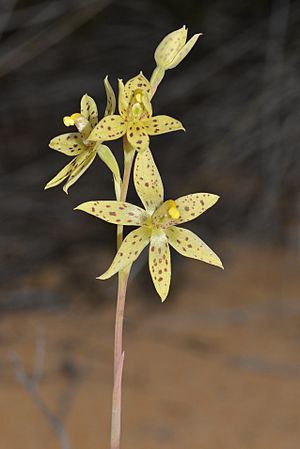Freckled sun orchid facts for kids
Quick facts for kids Freckled sun orchid |
|
|---|---|
 |
|
| Thelymitra sargentii growing near Northampton | |
| Scientific classification | |
| Genus: |
Thelymitra
|
| Species: |
sargentii
|
The freckled sun orchid (Thelymitra sargentii) is a special kind of orchid. It belongs to the plant family called Orchidaceae. This orchid grows only in Western Australia. It has one thick, leathery leaf. It can also have up to twenty-five flowers that smell very nice. These flowers are lemon yellow with brown spots, which is why it's called "freckled." This orchid grows in dry places. However, it gets water from rain that runs off nearby areas.
What Does It Look Like?
The freckled sun orchid grows from a tuber (a bit like a potato) underground. It is a plant that lives for many years. It has one stiff, leathery leaf that stands up straight. This leaf is usually about 10 to 25 centimeters (4 to 10 inches) long. It is also about 1 to 2 centimeters (about half an inch) wide.
The plant produces a tall flowering stem. This stem can be about 30 to 50 centimeters (12 to 20 inches) tall. It holds between five and twenty-five lemon yellow flowers. These flowers have brown spots and are about 3.5 to 4 centimeters (1.4 to 1.6 inches) wide.
The parts of the flower include sepals and petals. These are about 1.6 to 2 centimeters (0.6 to 0.8 inches) long. They are also about 0.5 to 0.7 centimeters (0.2 to 0.3 inches) wide. The central part of the flower is called the column. It is yellow and about 0.6 to 0.8 centimeters (0.2 to 0.3 inches) long. It is also about 0.3 centimeters (0.1 inches) wide.
The top part of the anther (where pollen is made) has an orange tip. This tip looks like it has a small notch. The back of it is bumpy. The side parts of the column have dense, yellow, pimply ends.
This orchid flowers in September and October. Its flowers have a strong scent. They are pollinated by insects. The flowers open up fully on warm, sunny days.
How Did It Get Its Name?
The freckled sun orchid was first officially described in 1930. This was done by a botanist named Richard Sanders Rogers. He wrote about it after a plant sample was collected by Oswald Sargent. The description was published in a scientific journal called Transactions of the Royal Society of South Australia.
The second part of its scientific name, sargentii, honors Oswald Sargent. He was the person who collected the very first plant sample. This sample is known as the type specimen.
Where Does It Live?
The freckled sun orchid mainly grows near shrubs and small trees. These plants help it by directing rainwater towards its roots. It grows on sandy plains. You can find it in Western Australia. Its habitat stretches between places like Kalbarri, Kalgoorlie, and Hyden.
Is It Safe?
The Western Australian Government's Department of Parks and Wildlife keeps track of plants. They have looked at the freckled sun orchid. They have officially said that it is "not threatened." This means it is not currently in danger of disappearing.

